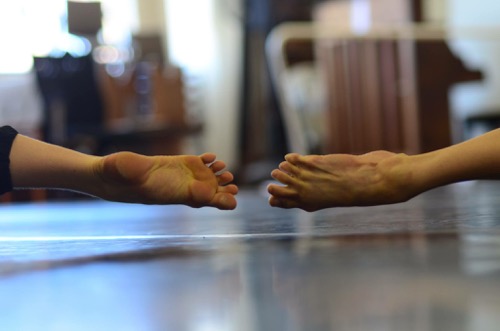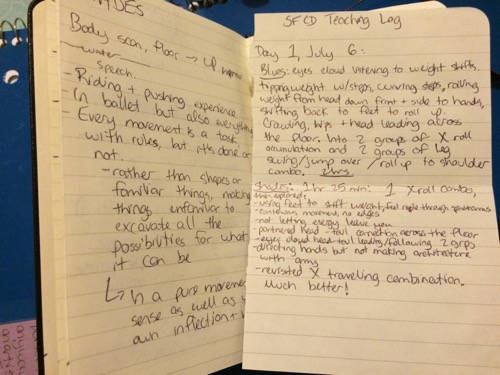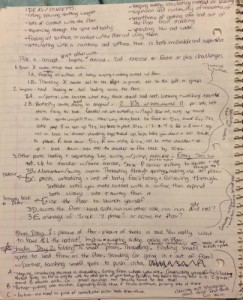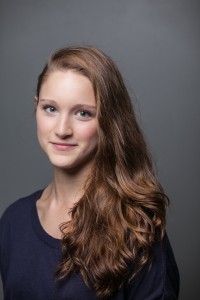
by Emma Love Suddarth
“My ankle is jammed.”
If you ask Boyd Bender, the Pacific Northwest Ballet’s Director of Physical Therapy Services (and physical therapist), how many times over his years with the company he has heard that sentence, his answer would be in the thousands. He’s a wizard when it comes to mending those ankles that suddenly feel stuck, restricted, or “out of place” from a hard landing or a sudden torque. However, Bender didn’t acquire 30 years of thankful dancers based solely on ankle pulls.
If you walked into the PNB studios on an average Tuesday and felt the need to address that acute back pain that came on yesterday, or that chronic tendonitis that has intensified over a long rehearsal period, you would head straight for the sign-up sheet on the PT board. Bender and his fellow PTs’ hours vary depending on the day of the week, and any dancer can sign up for a 15-minute slot within that period.
The system at the theater during performance time is different; it consists of a dry erase board and markers (which festively turn red and green over Nutcracker season) and a first-come-first-serve type of sign up. The schedule fills up fast in both settings—and the battles over the pen or marker to get your name down first are frequent. While the session time allotment may seem brief, it is only a part of ongoing, continual care. While Bender’s treatment begins at the onset, sudden or not, of the problem, it is rarely a “one-visit” fix and requires regular visits to his table for repeated care. He even acts as frequent liaison between dancers and the sports medicine doctor, massage therapists, or outside PTs (to name a few). The time spent with the company PT is both extremely necessary and immeasurably valuable—one of the most essential elements in a dancer’s career.

In PNB’s case, there are numerous generations of dancers who swear by Boyd Bender’s care. His breadth of knowledge is not just incredibly vast, but also constantly expanding. Not only must his know-how encompass the entirety of the human body, but it also must address the variety of situations that a dance career might require that body to end up in. The physical issues that arise from Kent Stowell’s Swan Lake are very different than those from William Forsythe’s One Flat Thing, reproduced; and, when the transition time between the reps spans only two days, Bender must be immediately ready to address the new problems that the dancers bring in to him.
Bender, his fellow PTs, the company sports medicine doctor, the massage therapists, the company manager, and the artistic director—Peter Boal, who also offers a dancer’s perspective on each work— routinely meet in order to discuss the physical requirements of the specific reps, as well as to keep track of the overall health of the company. On top of that, Bender sometimes watches videos of the pieces prior to the rep as to get a feel for issues that might arise. He compares this practice to a similar one in football—where PTs will also study videos of upcoming competitors to see how and where they hit, in order to prepare as best they can to address the players’ physical needs. However, most of all he prefers to rely heavily on the information the dancers bring to him in the beginning of the process in order to gauge what to expect. While each dancer’s body is different, and predisposed to varying pains and problems, specific trends oftentimes surface over the course of a single rep.

During Swan Lake, his table was occupied by a never-ending stream of swans with any number of lower leg problems—a common one being a bad calf. The audience might likely never think of it, but those swans encircling the stage, standing motionless on one leg for the entirety of the 2nd and 4th act pas de deux, are aching and sweating more than if they were dancing. By the end of the run almost every swan had a bad right or left calf, depending on which side of the stage she stood. However, three days later, one of those same swans is back on Bender’s table at the studios, attempting to put words to the intense neck pain she is experiencing due to a certain motion of One Flat Thing, which she then gingerly, very cautiously demonstrates. Boyd is ready for all of it.
Thirty seconds after a horrific ankle sprain, Bender is in the room ready to help. Ten years of on-and-off Achilles tendonitis, Bender is still finding new ways of caring for it. His arsenal of tools and skills is immeasurable; whether he is adjusting, lasering, ultra-sounding, taping, massaging, scraping, or even exercising (that’s right, it’s not all passive!) the problematic area, he’s thoroughly monitoring, addressing, and protecting the entirety of the dancer’s physical well-being. I, and numerous others, can easily name more than one instance that I likely wouldn’t have been back on stage that evening if it wasn’t for Bender’s care. You might never realize that one vertebra on your back being out of place is the reason for the shooting nerve pain in the back of your knee—but Bender knows.
And he’ll fix it too.
Pacific Northwest Ballet’s season resumes in June with their “Love & Ballet” program. Get more details by visiting the PNB website.

Contributor Emma Love Suddarth is from Wichita, Kansas. She studied with Sharon Rogers and on scholarship at Pacific Northwest Ballet School, and attended summer courses at Central Pennsylvania Youth Ballet, Ballet Academy East, and Pacific Northwest Ballet School. She was first recipient of the Flemming Halby Exchange with the Royal Danish Ballet School and was also a 2004 and 2005 recipient of a Kansas Cultural Trust Grant. She joined Pacific Northwest Ballet as an apprentice in 2008 and was promoted to corps de ballet in 2009.
While at PNB, she has performed featured roles in works by George Balanchine, Peter Boal, David Dawson, Ulysses Dove, William Forsythe, Jiri Kylian, Mark Morris, Margaret Mullin, Crystal Pite, Alexei Ratmansky, Kent Stowell, Susan Stroman, and Price Suddarth. Some of her favorites include the Siren in Balanchine’s The Prodigal Son, Jiri Kylian’s Petit Mort, David Dawson’s A Million Kisses to My Skin, William Forsythe’s New Suite, and Price Suddarth’s Signature.
She is a contributor to Pacific Northwest Ballet’s blog. She is married to fellow PNB dancer Price Suddarth.












